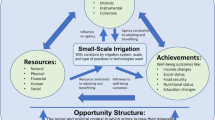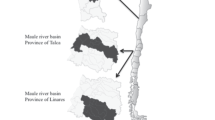Abstract
Water saving irrigation (WSI) is promoted as a strategy to mitigate future water stresses by the Chinese government and irrigation scientists. However, the dissemination of WSI in China has been slow and little is understood with respect to why farmers adopt WSI or how WSI interacts with the social and institutional contexts in which it is embedded. By analyzing qualitative data from 37 semi-structured and 56 unstructured interviews across 13 villages in northwest China, this paper examines smallholder farmers’ knowledge and perceptions of WSI, and how WSI interacts with farmer livelihood decision-making and extant systems of land and water management. The results show that smallholders’ willingness to adopt and continuously use WSI was dampened by (1) a lack of communal capital and measures for conflict resolution, (2) a disconnect between the temporal demands of practicing WSI and the ways farmers prioritize different livelihood strategies, (3) misconceptions about WSI systems and how they work, (4) market risks, and (5) landownership structure and economies of scale. These results suggest that programs for promoting WSI must be holistic in nature and address smallholders’ day-to-day problems. Understanding why WSI did not succeed in some places will help formulate policy interventions that avoid reproducing conflicts, risks, and technological malfunctions responsible for previous failure.

Similar content being viewed by others
Notes
Village names are omitted to protect their identity.
An employee of the company that paid for and installed the DI system explained that the company recommended each farmer plant the same crop but that villagers refused.
References
Agnew, C., and P. Woodhouse. 2011. Water resources and development. New York, NY: Routledge.
Babbie, E. 2013. The basics of social research, 6th ed. Belmont, CA: Wadsworth.
Belder, P., D. Rohrbach, S. Twomlow, and A. Senzanje. 2007. Can drip irrigation improve the livelihoods of smallholders? Lessons learned from Zimbabwe. Global Theme on Agroecosystems Report 33. Zimbabwe: International Crops Research Institute for the Semi-Arid Tropics.
Bernstein, L., and L.E. Francois. 1973. Comparisons of drip, furrow, and sprinkler irrigation. Soil Science 115(1): 73–86.
Birkenholtz, T. 2009. Irrigated landscapes, produced scarcity, and adaptive social institutions in Rajasthan, India. Annals of the Association of American Geographers 99(1): 118–137.
Blanke, A., S. Rozelle, B. Lohmar, J. Wang, and J. Huang. 2007. Water saving technology and saving water in China. Agricultural Water Management 87(2): 139–150.
Boelens, R. 2009. The politics of disciplining water rights. Development and Change 40(2): 307–331.
Brookfield, H. 2008. Family farms are still around: Time to invert the old agrarian question. Geography Compass 2(1): 108–126.
Browne, K. 2005. Snowball sampling: Using social networks to research non-heterosexual women. International Journal of Social Research Methodology 8(1): 47–60.
Burney, J.A., and R.L. Naylor. 2012. Smallholder irrigation as a poverty alleviation tool in Sub-Saharan Africa. World Development 40(1): 110–123.
Carney, J.A. 1998. Women’s land rights in Gambian irrigated rice schemes: Constraints and opportunities. Agriculture and Human Values 15: 325–336.
Cheng, H., and Y. Hu. 2012. Improving China’s water resources management for better adaptation to climate change. Climatic Change 112(2): 253–282.
Cook, S., and H. Wei. 2002. The anomalous nature of development success: A case study from China. Development 45: 76–80.
Deng, X., L. Shan, H. Zhang, and N.C. Turner. 2006. Improving agricultural water use in arid and semiarid areas of China. Agricultural Water Management 80: 23–40.
Eakin, H. 2005. Institutional change, climate risk, and rural vulnerability: Cases from central Mexico. World Development 33(11): 1923–1938.
Eakin, H. 2003. The social vulnerability of irrigated vegetable farming households in central Puebla. Journal of Environment and Development 12(4): 414–429.
Friedlander, L., A. Tal, and N. Lazarovitch. 2013. Technical considerations affecting adoption of drip irrigation in sub-Saharan Africa. Agricultural Water Management 126: 125–132.
Gamble, J. 2003. Shanghai in transition: Changing perspectives and social contours of a Chinese metropolis. New York, NY: RoutledgeCurzon.
Glaser, B.G., and A.L. Strauss. 1967. The discovery of grounded theory: Strategies for qualitative research. Chicago, IL: Aldine Publishing Company.
Haile, A.M., H. Depeweg, and B. Stillhardt. 2003. Smallholder drip irrigation technology. Mountain Research and Development 23(1): 27–31.
Harris, L.M. 2008. Water rich, resource poor: Intersections of gender, poverty, and vulnerability in newly irrigated areas of southeastern Turkey. World Development 36(12): 2643–2662.
Kulecho, I.K., and E.K. Weatherhead. 2006. Adoption and experience of low cost drip irrigation in Kenya. Irrigation and Drainage 55: 435–444.
Kulecho, I.K., and E.K. Weatherhead. 2005. Reasons for smallholder farmers discontinuing with low-cost micro-irrigation: A case study from Kenya. Irrigation and Drainage Systems 19(2): 179–188.
Lee, D.R. 2005. Agricultural sustainability and technology adoption: Issues and policies for developing countries. American Journal of Agricultural Economics 87(5): 1325–1334.
Lin, X., and L. Zhao. 1999. Water saving technology for surface irrigation of dry land crops. Beijing, China: Water Power Press.
Liu, C., D. Golding, and G. Gong. 2008. Farmer’s coping response to the low flows in the lower Yellow River: A case study of the temporal dimensions of vulnerability. Global Environmental Change 18(4): 543–553.
Liu, H., and G. Huang. 2009. Laboratory experiment on drip emitter clogging with freshwater and treated sewage effluent. Agricultural Water Management 96: 745–756.
Lohmar, B., J.X. Wang, S. Rozelle, J.K. Huang, and D. Dawe. 2003. China’s agricultural water policy reforms: Increasing investment, resolving conflicts, and revising incentives. Market and Trade Economics Division, Economic Research Service, US Department of Agriculture, Agriculture Information Bulletin Number 782, Washington DC.
Morris, J., J. Mills, and I.M. Crawford. 2000. Promoting farmer uptake of agri-environment schemes: The countryside stewardship arable options scheme. Land Use Policy 17(3): 241–254.
Moyo, R., D. Love, M. Mul, W. Mupangwa, and S. Twomlow. 2006. Impact and sustainability of low-head drip irrigation kits, in the semi-arid Gwanda and Beitbridge Districts, Mzingwane Catchment, Limpopo Basin, Zimbabwe. Physics and Chemistry of the Earth, Parts 31(15–16): 885–892.
Muldavin, J. 1996. The political ecology of agrarian reform in China. In Liberation ecologies: Environment, development, social movements, ed. R. Peet, and M. Watts, 227–259. New York, NY: Routledge.
Murphy, R. 2002. How migrant labor is changing rural China. Cambridge, UK: Cambridge University Press.
Mustafa, D., and M.U. Qazi. 2007. Transition from Karez to tubewell irrigation: development, modernization, and social capital in Balochistan, Pakistan. World Development 35(10): 1796–1813.
Namara, R.E., R.K. Nagar, and B. Upadhyay. 2007. Economics, adoption determinants, and impacts of micro-irrigation technologies: Empirical results from India. Irrigation Science 25(3): 283–297.
Nation, M.L. 2010. Understanding women’s participation in irrigated agriculture: A case study from Senegal. Agriculture and Human Values 27: 163–176.
National Bureau of Statistics of China. 2010. Statistical communique of the People’s Republic of China on the 2009 national economic and social development. Beijing, China: National Bureau of Statistics of China. www.stats.gov.cn/was40/gjtjj_en_detail.jsp?channelid=1175&record=59. Accessed 10 Oct 2013.
Neuman, W.L. 2011. Social research methods: Qualitative and quantitative approaches, 7th ed. Boston, MA: Pearson.
Noy, C. 2008. Sampling knowledge: The hermeneutics of snowball sampling in qualitative research. International Journal of Social Research Methodology 11(4): 327–344.
Pedersen, S.M., M.V. Boesen, and J.E. Ørum. 2013. Institutional and structural barriers for implementing on-farm water saving irrigation systems. Food Economics 9: 11–26.
Postel, S. 2000. Entering an era of water scarcity: The challenges ahead. Ecological Applications 10(4): 941–948.
Postel, S., P. Polak, F. Gonzales, and J. Keller. 2001. Drip irrigation for small farmers: A new initiative to alleviate hunger and poverty. Water International 26(1): 3–13.
Ringler, C., A. Bhaduri, and R. Lawford. 2013. The nexus across water, energy, land, and food (WELF): Potential for improved resource use efficiency? Current Opinion in Environmental Sustainability 5(6): 617–624.
Rogers, E.M. 2003. Diffusion of innovations, 5th ed. New York, NY: The Free Press.
Shah, T., and J. Keller. 2002. Micro-irrigation and the poor: a marketing challenge in smallholder irrigation development. In Proceedings of private irrigation in Sub-Saharan Africa: Regional seminar on private sector participation and irrigation expansion in Sub-Saharan Africa, ed. H. Sally, and C.L. Abernathy, 165–183. Accra, Ghana: FAO.
State Council Information Office of China. 2008. China’s policies for addressing climate change. Beijing, China: State Council Information Office of China.
Van der Kooij, S., M. Zwartevee, H. Boesveld, and M. Kuper. 2013. The efficiency of drip irrigation unpacked. Agricultural Water Management 123: 103–110.
Wang, J., J. Huang, S. Rozelle, Q. Huang, and L. Zhang. 2009. Understanding the water crisis in Northern China: What the government and farmers are doing. International Journal of Water Resources Development 25(1): 141–158.
Wang, H., C. Liu, and L. Zhang. 2000. Water-saving agriculture in China: An overview. Advances in Agronomy 75: 135–171.
Webber, M., J. Barnett, B. Finlayson, and M. Wang. 2008. Pricing China’s irrigation water. Global Environmental Change 18: 617–625.
Westarp, S.V., S. Chieng, and H. Schreier. 2004. A comparison between low-cost drip irrigation, conventional drip irrigation, and hand watering in Nepal. Agricultural Water Management 2(15): 143–160.
Woltering, L., D. Pasternak, and J. Ndjeunga. 2011. The African market garden: the development of a low-pressure drip irrigation system for smallholders in the sudano sahel. Irrigation and Drainage 60(5): 613–621.
Wong, J.L. 2010. The food-energy-water nexus: an integrated approach to understanding China’s resource challenges. Harvard Asia Quarterly Spring 2010: 15–19.
Wu, P., D. Zhu, J. Jin, and W. Niu. 2010. Design of drip irrigation lateral for optimum capital and operating cost. Water Science and Technology 10(6): 943–951.
Yang, H., X. Zhang, and A.J.B. Zehnder. 2003. Water scarcity, pricing mechanism, and institutional reform in northern China irrigated agriculture. Agricultural Water Management 61(2): 143–161.
Ye, J., C. Wang, H. Wu, C. He, and J. Liu. 2013. Internal migration and left-behind populations in China. Journal of Peasant Studies 40(6): 1119–1146.
Yu, C. 2011. China’s water crisis needs more than words. Nature 470: 307.
Zhou, S., T. Herzfeld, T. Glauben, Y. Zhang, and B. Hu. 2008. Factors affecting Chinese farmers’ decisions to adopt a water-saving technology. Canadian Journal of Agricultural Economics 56: 51–61.
Zhu, X., Y. Li, M. Li, Y. Pan, and P. Shi. 2013. Agricultural irrigation in China. Journal of Soil and Water Conservation 68(6): 147A–154A.
Zou, X., Y. Li, Q. Gao, and Y. Wan. 2012. How water saving irrigation contributes to climate change resilience—a case study of practices in China. Mitigation and Adaptation Strategies for Global Change 17(2): 111–132.
Acknowledgments
This research was partially funded by Northwest Agriculture and Forestry University (NWAFU) through the 111 project of Chinese Ministry of Education (No. B12007) and Utah Agricultural Experiment Station. The authors are grateful to Drs. Pute Wu, Youke Wang, Xining Zhao, Xiping Liu, Yubao Wang from NWAFU and Roger Kjelgren from Utah State University for their continuous support for this research. The authors also thank Chunyan Qi and Mengying Sun for their assistance during fieldwork.
Author information
Authors and Affiliations
Corresponding author
Rights and permissions
About this article
Cite this article
Burnham, M., Ma, Z. & Zhu, D. The human dimensions of water saving irrigation: lessons learned from Chinese smallholder farmers. Agric Hum Values 32, 347–360 (2015). https://doi.org/10.1007/s10460-014-9565-8
Accepted:
Published:
Issue Date:
DOI: https://doi.org/10.1007/s10460-014-9565-8




